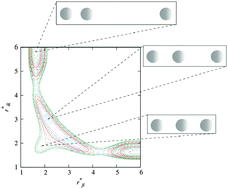Equilibrium properties of the reaction H2 ⇌ 2H by classical molecular dynamics simulations
Abstract
We have developed a classical molecular dynamics model for the hydrogen dissociation reaction, containing two- and three-particle potentials derived by Kohen, Tully and Stillinger. Two fluid densities were investigated for a wide range of temperatures, and 11 fluid densities were considered for one temperature. We report the temperature range where the degree of reaction is significant, and also where a stable molecule dominates the population in the energy landscape. The three-particle potential, which is essential for the reaction model and seldom studied, together with the two-particle interaction lead to a large effective excluded volume diameter of the molecules in the molecular fluid. The three-particle interaction was also found to give a large positive contribution to the pressure of the reacting mixture at high density and/or low temperatures. From knowledge of the dissociation constant of the reaction and the fluid pressure, we estimated the standard enthalpy of the dissociation reaction to be 430 kJ mol−1 (ρ = 0.0695 g cm−3) and 380 kJ mol−1 (ρ = 0.0191 g cm−3). These values are in good agreement with the experimental vaule of 436 kJ mol−1 under ambient pressure. The model is consistent with a Lennard-Jones model of the molecular fluid, and may facilitate studies of the impact of chemical reactions on transport systems.


 Please wait while we load your content...
Please wait while we load your content...